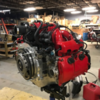Hi everyone,
I would love any tips or guidance anyone can offer!
I have a relatively new Jps Speedster - with a 2.5 Suburu SOHC engine, and the oil temp gauge gets to the redline within 10-15 mins of driving, and i'm struggling to work out what the issue is
Oil and coolant are all new and at appropriate levels and given the car has only done 1500 miles its basically still a new car (though i've owned the car for 3 years now)
I'm also having ongoing issues with the gear linkage too - all gears work fine, apart from 1st to 2nd and 3rd to 2nd ... i have a Vintage Speed Shifter.
Getting hold of the JPS team to help is pretty much impossible so would welcome any guidance you can offer!
Also if anyone has any good mechaic reco's for NYC i'd welcome them! i'm struggling to find anyone who can work on the car - i tried speaking to the team at BAY DIAGNOSTICS in Brooklyn - they were super friendly but can't take it on
Thanks for in advance for any advice you can share,
















